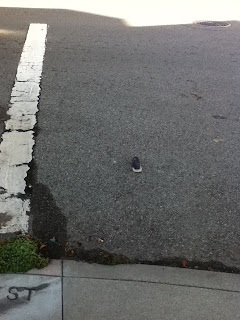Saturday, December 29, 2012
Walking on eggshells hurts your feet
From Seating Arrangements, by Maggie Shipstead:
“The weekend, now surveyed from its near edge, felt daunting, not a straightforward exercise in familial peacekeeping and obligatory cheer but a treacherous puzzle, full of opportunities for the wrong thing to be said or done.”
Saturday, November 10, 2012
Yoga bliss
In our ordinary sedentary lives, we put our bodies through a very limited number of actions and positions. What’s wonderful about yoga is the vast variety of actions and the full range of positions it moves you through in a single hour or two.
And in our ordinary sedentary lives, we continually fold ourselves up into small parcels, bending at the knees and hips and often rounding our shoulders at our desks. In yoga, we live large, fully extending our limbs, pushing down and reaching up.
That must be why you feel so alive after a really thorough class.
Looking good is hard
Clothing makes the woman, or so my friend K believes. Not long ago, she gave me gift—a tour through her closet and through the boutique that supplies her closet.
“Why are you wearing boys’ clothes?” she asked. I had arrived wearing made-in-China sneakers, 501 Levi jeans, a Uniqlo T-shirt and, yes, a long black Gap hoodie. That’s my typical daywear. And until K exploded with disapproval, I thought it suited me. And it’s cheap and comfortable—though the jeans do pinch my parts sometimes.
So K started dressing me in her clothes—mostly silky black drapery—and to tell the truth, I looked a lot better in her clothes than in mine.
Then she took me to the boutique, and the owner, who’s a stylist for wealthy clients, selected clothes for me to try on—also mostly silky black drapery. And I looked fabulous—actually beautiful.
Then I looked at the price tags: $100 for a knit top, $200 for a microfiber sweater, $1,500 for a microfiber jacket. I knew I was supposed to buy something. Indeed, K threatened to buy something for me if I didn’t buy something for myself. But I couldn’t do it.
K, who is retired and has only modest savings, says she has decided to spend her money on clothing, since it gives her pleasure and make her feel good about herself. She changes outfits four times a day. She gets her eyebrows dyed!
She does look wonderful, I admit it. And I was swayed by her argument that clothing can be therapeutic. My clothes, she told me, betrayed a deep lack of self-confidence. I deserved to feel good about myself, she said.
Yes!
But I was torn. And it wasn’t just the money. Or at least that’s what I told myself. I wear mostly cotton; the clothes that looked best were synthetics. I wash my clothes in the washing machine, with water; the clothes that looked best needed dry cleaning, with chemicals. The clothes that looked best were less comfortable than the ones I’d arrived in. And yes, I was troubled by the extravagance. How could I ever justify to thrifty Other—who spends no money on anything ever—outfits that cost thousands of dollars?
In the end, I couldn’t do it. I think about the beautiful, elegant woman I saw in the mirror that day, and wish I could see her again. But I’m not sure I will.
Friday, November 9, 2012
Two r's down, one to go
I’m haphazard at reduce-reuse-recycle. I go through the motions but have fall-through, particularly in the reduce arena. But I just had a great flash in the reuse-recycle domain: Cut up old yoga mats into innersoles for your shoes. It would totally work. Right?
Two wrongs make a right
I’ve been smarting for several days because of a trivial snafu. On the last leg of my journey back from California, I got stuck in a subway turnstile with my luggage. I swiped my card twice to try to extricate myself. It didn’t work, and in the end the agent in the booth buzzed me through the emergency gate. He did not, however, return the extra fare I’d paid. It’s a small thing in the big scheme. After all, the subway was actually running just a few days after Hurricane Sandy shut the system down, and the lost fare amounted to only about $2. Still …
Then yesterday, I was rushing to work and got an “Insufficient Fare” reading as I tried to go through the turnstile with my pay-per-ride card. Sigh. I headed for the card machine, knowing it wouldn’t work—they never do—and that I’d have to go to a more distant station staffed by an agent. Suddenly, a young man stepped up and offered to swipe me through with his unlimited card. I knew it wasn’t the right thing to do.
But it felt so good!
Friday, November 2, 2012
Monday, October 29, 2012
Saturday, October 27, 2012
Secret vanities
Does everyone have these—fabulous fashion statements that cannot be aired in public? I have a closetful of them: extravagantly tiered and flared bellbottoms that 40 years after I stopped being a hippie and started being hippy I secretly think look pretty great, halter tops that reveal shoulders and arms that I pride myself are still youthful but my daughter assures me are not (“Just no!”), circle skirts that went out of style when I was 10 but remain a personal vice (I think of them as “swirl skirts”), satin palazzo pants that remain the height of glamour (to me alone), the maryjanes that make other women look like dancers but that Other says make me look like a clown, and (don’t laugh) hunter’s-camouflage shirts—you know, the ones with trees and leaf litter.
There are more. Many are unworn, or worn only in the most indulgent company (my own), but the whims that made me buy them just keep resurfacing. Many of the daffiest arrived straight from Daffy’s, the aptly named well-loved “Bargains for Millionaires” store, which closed its doors a few weeks ago, so I suppose my collecting days may be over.
The thing is, the styles that now look best on me—sportswear and business clothes—don’t appeal to me. I don’t identify with the image they project: severe, competent, crisp, sure. And I don’t seek out that kind of woman for friendship. How did this dysmorphia happen? And will it ever end?
Monday, October 22, 2012
The 1% fallacy
There are many things to criticize my parents for. They are quarrelsome, stubborn and self-absorbed. But they share a remarkable quality that, alas, I did not inherit: optimism.
If they see me worrying, my mom will say, “Oh, you’ll be fine” or “Don’t be silly. I’ll be fine.” My dad will wave away my concerns like dust in a mote.
My mom refuses to use her walker with the same degree of conviction as that of the doctor who insisted she must never budge without it. My dad won’t take a cab if there’s a bus that will get him there, although he often can’t find a seat and he has a little problem with vertigo. Sometimes I feel like I’m going to die of stress watching them blindly lurch around, evading catastrophe after catastrophe by no more than a hair. They’re like Mr. and Mrs. Magoo.
And the thing is, 99% of the time they’re right. Most things do turn out just fine. And even if they don’t, it often doesn’t matter.
My parents focus on that 99%. I focus on the 1%. It’s illogical, but I reason that if I worry about something, it won’t happen or I’ll be more prepared if it does. So I do a lot of prophylactic worrying. The problem is, prophylactic worrying doesn’t work. Bad shit happens even if you foresee it and worry it to death.
So I don’t want to raise my children the way my parents raised me or treat my friends the way they treated theirs. But in this one respect—relentless, irrational optimism—I’d like to be just like my parents.
Monday, October 15, 2012
Divinity in the details
In the early years of my yoga practice—really,
for the first 30 years—I did little more than assume the shapes of the poses. I
looked at what the teacher did and folded myself into the same configuration of
arms and legs. I ignored verbal instructions—too boring!
But in the past five years, I’ve started to
listen to the details and enter poses from the inside out. It’s a completely
different experience. “Widen your thighs, drop your tailbone, firm your lower
abdominals, lift your ribs, press your shoulder blades into your back …” The
simplest pose is the culmination of scores of invisible actions. And though
they’re hard to do, the details are not boring at all. They’re exciting, it
turns out!
Sunday, October 14, 2012
Shopping for the cure
I was telling a writer-friend last night that my
attention span seems to be shrinking with age. From the moment I undertake a
task, I focus not on problem-solving it or doing it well but on how quickly I
can get it done, no matter how haphazardly, or how I can get out of doing it
entirely. A task that requires concentration sends my mind spinning in the
opposite direction. The prospect of mental effort makes me feel tired
before I begin.
“Yes,” she said. “But it’s weird how even though
I can’t settle into writing, I can immediately focus on, say, shopping
online and be completely absorbed for hours.”
So I guess the cure for my ADD is shopping!
Digitally remastered
I have a
disorder called Dupuytren’s contracture, which causes my right hand to develop
hard cords and lumps that pull my little finger into my palm. It’s not a
life-threatening illness, but it limits my yoga practice—no downward-facing
dogs or handstands—though I suppose it could expand my practice if I would only
view it as an exercise in non-attachment to such earthly achievements.
The treatments
can be radical: amputation of the affected digit; surgery to open the palm to
remove the cords, which requires skin grafts and months of physical therapy;
painful injections with cord-dissolving chemicals derived from gangrene
bacteria; doing nothing and just living with the limitations.
This is what it
looks like:
There is another treatment, not much practiced
in the U.S., called needle aponeurotomy. In this less-is-more technique, the
surgeon injects lidocaine into your palm and finger and uses the sharp edge of
the needle to perforate the cord—over and over—then stretches the finger to
break the cord into unattached segments. It requires no systemic anesthesia and
no PT other than wearing a spring-loaded splint at night, and you can use your
hand almost immediately.
I did this four days ago. I can’t do
weight-bearing exercises for another week or so, but here’s what it looked like 24 hours after the procedure:
Subscribe to:
Posts (Atom)











